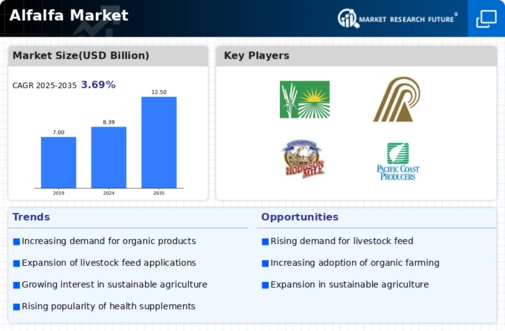Top Industry Leaders in the Alfalfa Market
 The competitive landscape of the alfalfa market is characterized by a mix of established players, strategic initiatives, and emerging trends. Key players in the industry play a pivotal role in shaping the market dynamics, and their strategies often define the overall competitive scenario.
The competitive landscape of the alfalfa market is characterized by a mix of established players, strategic initiatives, and emerging trends. Key players in the industry play a pivotal role in shaping the market dynamics, and their strategies often define the overall competitive scenario.
Key Players:
Al Dahra ACX Global, Inc. (US)
GrupoOsés (Spain)
Anderson Hay & Grain Inc. (US)
Alfalfa Monegros, S.L. (Spain)
Border Valley (US)
Bailey Farms (US)
Green Prairie International (Canada)
Cubeit Hay Company (Spain)
Hay USA Inc. (US)
Carli Group (Italy)
Standlee Hay Co Ltd. (US)
M&C Hay (US)
Haykingdom Inc. (US)
SL Follen Company (US)
McCracken Hay Company (US).
Strategies Adopted By Alfalfa Market Key Players:
The alfalfa market employ various strategies to maintain and enhance their market positions. These strategies often include mergers and acquisitions, collaborations with research institutions, and investments in advanced technologies. Companies focus on developing genetically modified alfalfa varieties to improve yield, resistance to diseases, and nutritional content. Furthermore, strategic alliances with farmers and distributors help these players strengthen their supply chains and broaden their market reach.
Market Share Analysis:
The alfalfa industry is influenced by several factors. These include product quality, pricing strategies, distribution channels, and brand reputation. Companies that consistently invest in research and development to introduce innovative products gain a competitive edge. Moreover, effective marketing and promotional activities contribute to brand visibility, influencing consumer preferences and market share.
News & Emerging Companies:
The alfalfa market has witnessed the emergence of new entrants seeking to capitalize on growing demand and changing consumer preferences. These companies often bring innovation to the market, introducing novel cultivation techniques or value-added products. Emerging companies such as Green Harvest and Sustainable Forage Solutions have attracted attention with their sustainable farming practices and commitment to environmental stewardship.
Industry Trends:
The alfalfa industry has experienced notable trends in terms of investments and developments. Many companies are focusing on sustainable and organic farming practices to meet the increasing consumer demand for environmentally friendly products. Investments in technology, including precision agriculture and data analytics, are gaining traction to optimize farming processes and improve overall efficiency.
Competitive Scenario:
The alfalfa market remains dynamic, with a mix of established players and emerging contenders. Intense competition prevails among key players, driving continuous innovation and improvements in farming practices. The market is also influenced by factors such as climate conditions, governmental regulations, and fluctuations in commodity prices, adding an additional layer of complexity to the competitive landscape.
Recent Development
The alfalfa market witnessed significant developments that reshaped the competitive landscape. One noteworthy trend was the increasing focus on sustainable and regenerative agriculture practices. Key players like Monsanto and Forage Genetics International announced initiatives to promote eco-friendly farming methods, aligning with the growing global emphasis on environmental conservation.
Additionally, there were strategic collaborations between major alfalfa producers and technology companies to integrate smart farming solutions. This involved the use of sensors, drones, and data analytics to optimize irrigation, monitor crop health, and enhance overall farm productivity. These technological advancements not only improved efficiency but also demonstrated a commitment to modernizing traditional agricultural practices within the industry.
Furthermore, mergers and acquisitions played a pivotal role in shaping the competitive landscape. Some companies engaged in strategic partnerships to consolidate their market positions and expand their product portfolios. These moves were often driven by the need to achieve economies of scale, enhance research and development capabilities, and strengthen global distribution networks.


